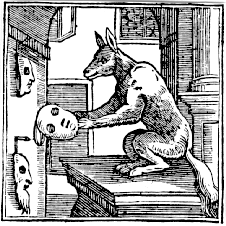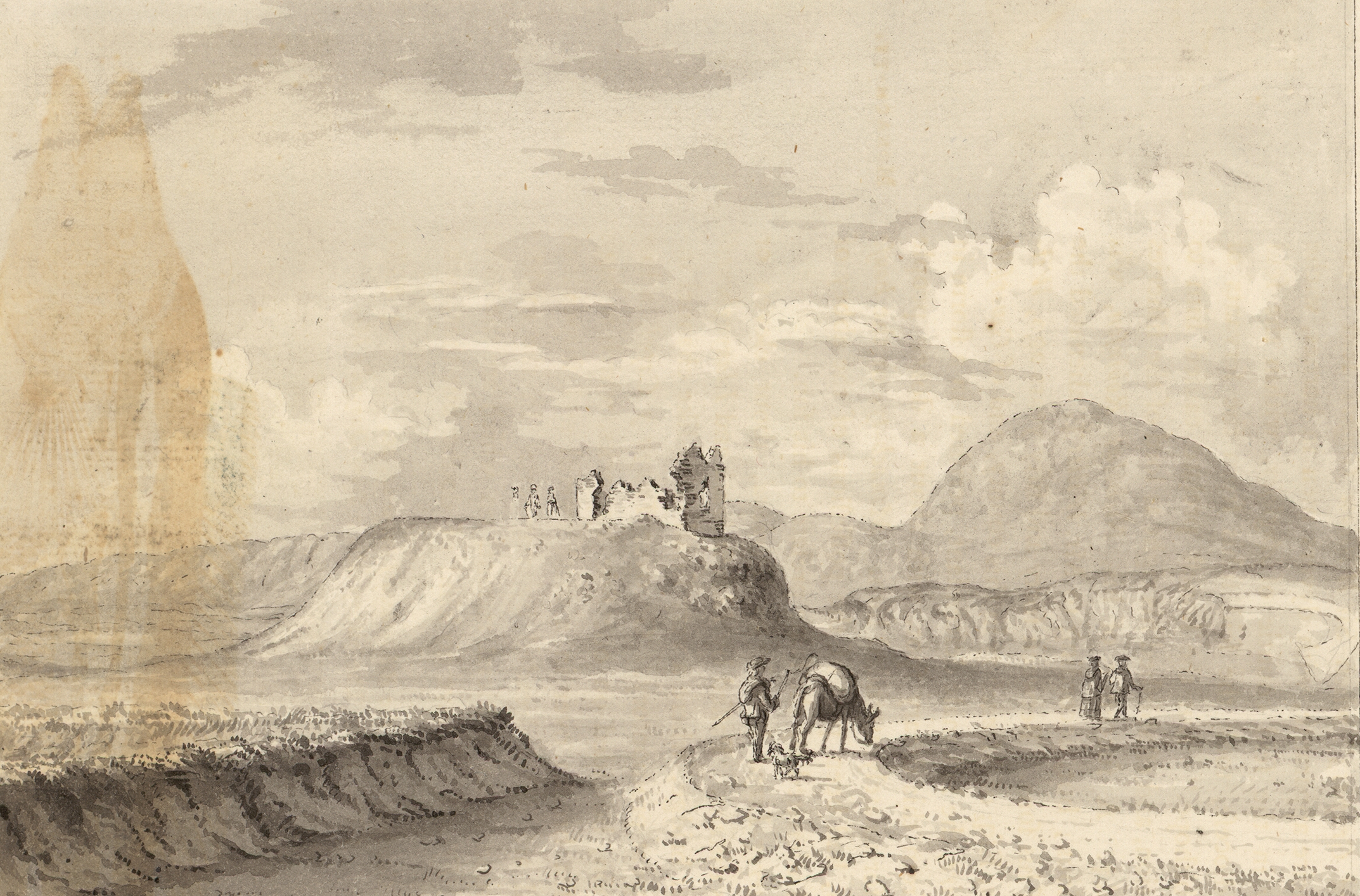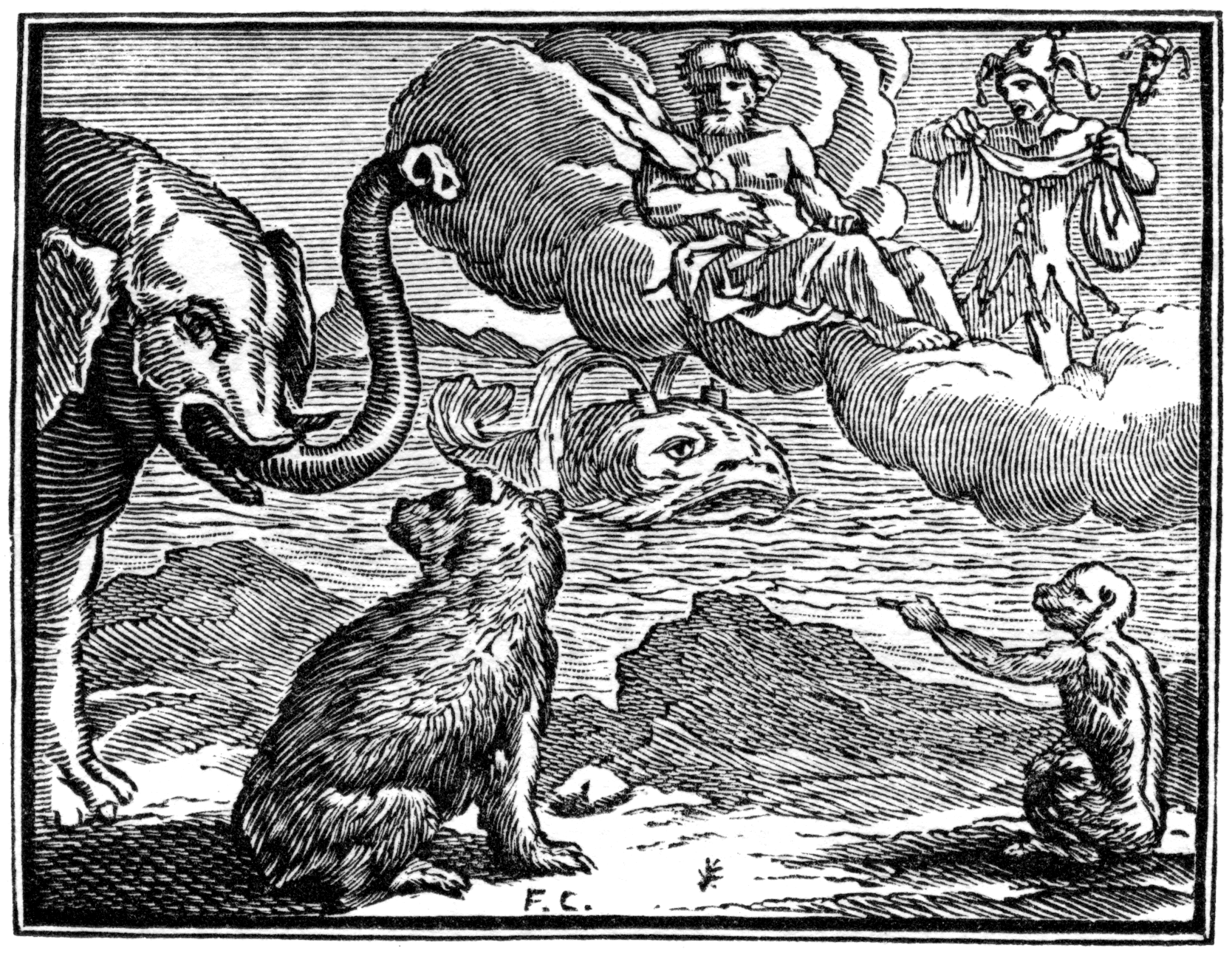|
The Mouse And The Oyster
The cautionary tale of The Mouse and the Oyster is rarely mentioned in Classical literature but is counted as one of Aesop's Fables and numbered 454 in the Perry Index. It has been variously interpreted, either as a warning against gluttony or as a caution against unwary behaviour. A warning to the unwary The earliest mention of the fable is in a Greek Anthology poem of the 1st century CE by Antiphilus of Byzantium. A house-mouse comes across an oyster and tries eating it, only for the shell to snap shut, bringing him at once both death and a tomb. In the following century, the orator Aelius Aristides gives the story a political interpretation as a warning to avoid entrapment in dangerous situations. A flowery Latin version of the Greek poem was made by Andrea Alciato for his book of emblems(1531), where it figures as a picture of greed. He was followed in this interpretation by the English emblematist Geoffrey Whitney, who turns it into a health warning: :::The Gluttons fatte, ... [...More Info...] [...Related Items...] OR: [Wikipedia] [Google] [Baidu] |
Aesop's Fables
Aesop's Fables, or the Aesopica, is a collection of fables credited to Aesop, a slave and storyteller believed to have lived in ancient Greece between 620 and 564 BCE. Of diverse origins, the stories associated with his name have descended to modern times through a number of sources and continue to be reinterpreted in different verbal registers and in popular as well as artistic media. The fables originally belonged to oral tradition and were not collected for some three centuries after Aesop's death. By that time, a variety of other stories, jokes and proverbs were being ascribed to him, although some of that material was from sources earlier than him or came from beyond the Greek cultural sphere. The process of inclusion has continued until the present, with some of the fables unrecorded before the Late Middle Ages and others arriving from outside Europe. The process is continuous and new stories are still being added to the Aesop corpus, even when they are demonstrably more ... [...More Info...] [...Related Items...] OR: [Wikipedia] [Google] [Baidu] |
Perry Index
The Perry Index is a widely used index of "Aesop's Fables" or "Aesopica", the fables credited to Aesop, the storyteller who lived in ancient Greece between 620 and 560 BC. The index was created by Ben Edwin Perry, a professor of classics at the University of Illinois Urbana-Champaign. Modern scholarship takes the view that Aesop probably did not compose all of the fables attributed to him;D. L. Ashliman, “Introduction,” in George Stade (Consulting Editorial Director), ''Aesop’s Fables.'' New York: Barnes & Noble Classics, (2005). Produced and published in conjunction with Fine Creative Media, Inc. (New York) Michael J. Fine, President and Publisher. See pp. xiii–xv and xxv–xxvi. indeed, a few are known to have first been used before Aesop lived, while the first record we have of many others is from well over a millennium after his time. Traditionally, Aesop's fables were arranged alphabetically, which is not helpful to the reader. Perry listed them by language (Greek ... [...More Info...] [...Related Items...] OR: [Wikipedia] [Google] [Baidu] |
Greek Anthology
The ''Greek Anthology'' ( la, Anthologia Graeca) is a collection of poems, mostly epigrams, that span the Classical and Byzantine periods of Greek literature. Most of the material of the ''Greek Anthology'' comes from two manuscripts, the ''Palatine Anthology'' of the 10th century and the '' Anthology of Planudes'' (or ''Planudean Anthology'') of the 14th century.: Explanatory text for the book of W. R. Paton entitled "The Greek Anthology with an English Translation" (1916), the same text is also at the introduction in page http://www.ancientlibrary.com/greek-anthology/ before the facsimile copy of the pages of the same book] The earliest known anthology in Greek was compiled by Meleager of Gadara in the first century BC, under the title ''Anthologia'', or "Flower-gathering." It contained poems by the compiler himself and forty-six other poets, including Archilochus, Alcaeus, Anacreon, and Simonides. In his preface to his collection, Meleager describes his arrangement o ... [...More Info...] [...Related Items...] OR: [Wikipedia] [Google] [Baidu] |
Aelius Aristides
Publius Aelius Aristides Theodorus ( grc-gre, Πόπλιος Αἴλιος Ἀριστείδης Θεόδωρος; 117–181 AD) was a Greek orator and author considered to be a prime example as a member of the Second Sophistic, a group of celebrated and highly influential orators who flourished from the reign of Nero until c. 230 AD. More than fifty of his orations and other works survive, dating from the reigns of Antoninus Pius and Marcus Aurelius. His early success was interrupted by a decades-long series of illnesses for which he sought relief by divine communion with the god Asclepius, effected by interpreting and obeying the dreams that came to him while sleeping in the god's sacred precinct; he later recorded this experience in a series of discourses titled ''Sacred Tales (Hieroi Logoi)''. In his later life, Aristides resumed his career as an orator, achieving such notable success that Philostratus would declare that "Aristides was of all the sophists most deeply versed in h ... [...More Info...] [...Related Items...] OR: [Wikipedia] [Google] [Baidu] |
Andrea Alciato
Andrea Alciato (8 May 149212 January 1550), commonly known as Alciati (Andreas Alciatus), was an Italian jurist and writer. He is regarded as the founder of the French school of legal humanists. Biography Alciati was born in Alzate Brianza, near Milan, and settled in France in the early 16th century. He displayed great literary skill in his exposition of the laws, and was one of the first to interpret the civil law by the history, languages and literature of antiquity, and to substitute original research for the servile interpretations of the glossators. He published many legal works, and some annotations on Tacitus and accumulated a sylloge of Roman inscriptions from Milan and its territories, as part of his preparation for his history of Milan, written in 1504–05. Among his several appointments, Alciati taught Law at the University of Bourges between 1529 and 1535. It was Guillaume Budé who encouraged the call to Bourges at the time. Pierre Bayle, in his General Dictiona ... [...More Info...] [...Related Items...] OR: [Wikipedia] [Google] [Baidu] |
Emblem Book
An emblem book is a book collecting emblems (allegorical illustrations) with accompanying explanatory text, typically morals or poems. This category of books was popular in Europe during the 16th and 17th centuries. Emblem books are collections of sets of three elements: an icon or image, a motto, and text explaining the connection between the image and motto. The text ranged in length from a few lines of verse to pages of prose. Emblem books descended from medieval bestiaries that explained the importance of animals, proverbs, and fables. In fact, writers often drew inspiration from Greek and Roman sources such as Aesop's Fables and Plutarch's Lives. Definition Scholars differ on the key question of whether the actual emblems in question are the visual images, the accompanying texts, or the combination of the two. This is understandable, given that first emblem book, the ''Emblemata'' of Andrea Alciato, was first issued in an unauthorized edition in which the woodcuts were ... [...More Info...] [...Related Items...] OR: [Wikipedia] [Google] [Baidu] |
Geoffrey Whitney
Geoffrey (then spelt Geffrey) Whitney (c. 1548 – c. 1601) was an English poet, now best known for the influence on Elizabethan writing of the ''Choice of Emblemes'' that he compiled. Life Geoffrey Whitney, the eldest son of a father of the same name, was born in or about 1548 at Coole Pilate, a township in the parish of Acton, four miles from Nantwich in Cheshire, where his family had been settled on a small estate since 1388. Educated at the neighbouring school of Audlem, he afterwards proceeded to Oxford University Oxford () is a city in England. It is the county town and only city of Oxfordshire. In 2020, its population was estimated at 151,584. It is north-west of London, south-east of Birmingham and north-east of Bristol. The city is home to the ..., and then for a longer period to Magdalene College, Cambridge. He seems to have left the university without a degree, going on to legal studies in London, where he was addressed in a poem by his sister dated 1573. ... [...More Info...] [...Related Items...] OR: [Wikipedia] [Google] [Baidu] |
Frome
Frome ( ) is a town and civil parish in eastern Somerset, England. The town is built on uneven high ground at the eastern end of the Mendip Hills, and centres on the River Frome. The town, about south of Bath, is the largest in the Mendip district of Somerset and is part of the parliamentary constituency of Somerton and Frome. The population was 28,559 in 2021. Frome was one of the largest towns in Somerset until the Industrial Revolution, and was larger than Bath from AD 950 until 1650. The town first grew due to the wool and cloth industry; it later diversified into metal-working and printing, although these have declined. The town was enlarged during the 20th century but retains a large number of listed buildings, and most of the centre falls within a conservation area. In the 2011 census, the population was given as 26,203. The town has road and rail transport links and acts as an economic centre for the surrounding area. It provides a centre for cultural and sportin ... [...More Info...] [...Related Items...] OR: [Wikipedia] [Google] [Baidu] |
Samuel Bowden (poet)
Samuel Bowden ( fl. 1733-1761) was an English physician and poet Bowden, from Frome, Somerset, was the author of two volumes of poems published from 1733-5. From the ''Gentleman's Magazine'', to which he was an occasional contributor, it is deduced that he was living in 1761, while a passing mention of him in 1778 is in the past tense. The writer adds that he was a friend of Elizabeth Singer Rowe, poet, and belonged to the same communion. Bowden was therefore a nonconformist Nonconformity or nonconformism may refer to: Culture and society * Insubordination, the act of willfully disobeying an order of one's superior *Dissent, a sentiment or philosophy of non-agreement or opposition to a prevailing idea or entity ** ..., and may be a relative of the Rev. John Bowden who preached Mrs. Rowe's funeral sermon. References * ;Attribution Year of birth missing Year of death missing 18th-century English people 18th-century English medical doctors People from Frome 18th ... [...More Info...] [...Related Items...] OR: [Wikipedia] [Google] [Baidu] |
Mock-heroic
Mock-heroic, mock-epic or heroi-comic works are typically satires or parodies that mock common Classical stereotypes of heroes and heroic literature. Typically, mock-heroic works either put a fool in the role of the hero or exaggerate the heroic qualities to such a point that they become absurd. History Historically, the mock-heroic style was popular in 17th-century Italy, and in the post-Restoration and Augustan periods in Great Britain. The earliest example of the form is the ''Batrachomyomachia'' ascribed to Homer by the Romans and parodying his work, but believed by most modern scholars to be the work of an anonymous poet in the time of Alexander the Great. A longstanding assumption on the origin of the mock-heroic in the 17th century is that epic and the pastoral genres had become used up and exhausted,Griffin,Dustin H. (1994) ''Satire: A Critical Reintroduction'p.135/ref> and so they got parodically reprised. In the 17th century the epic genre was heavily criticized, bec ... [...More Info...] [...Related Items...] OR: [Wikipedia] [Google] [Baidu] |
La Fontaine's Fables
Jean de La Fontaine collected fables from a wide variety of sources, both Western and Eastern, and adapted them into French free verse. They were issued under the general title of Fables in several volumes from 1668 to 1694 and are considered classics of French literature. Humorous, nuanced and ironical, they were originally aimed at adults but then entered the educational system and were required learning for school children. Composition history Divided into 12 books, there are 239 of the ''Fables'', varying in length from a few lines to some hundred, those written later being as a rule longer than those written earlier. The first collection of ''Fables Choisies'' had appeared March 31, 1668, dividing 124 fables into six books over its two volumes. They were dedicated to ''"Monseigneur"'' Louis, ''le Grand Dauphin'', the six-year-old son of Louis XIV of France and his queen consort Maria Theresa of Spain. By this time, La Fontaine was 47 and known to readers chiefly as the aut ... [...More Info...] [...Related Items...] OR: [Wikipedia] [Google] [Baidu] |

_-_Foto_G._Dall'Orto_5_ago_2006.jpg)





